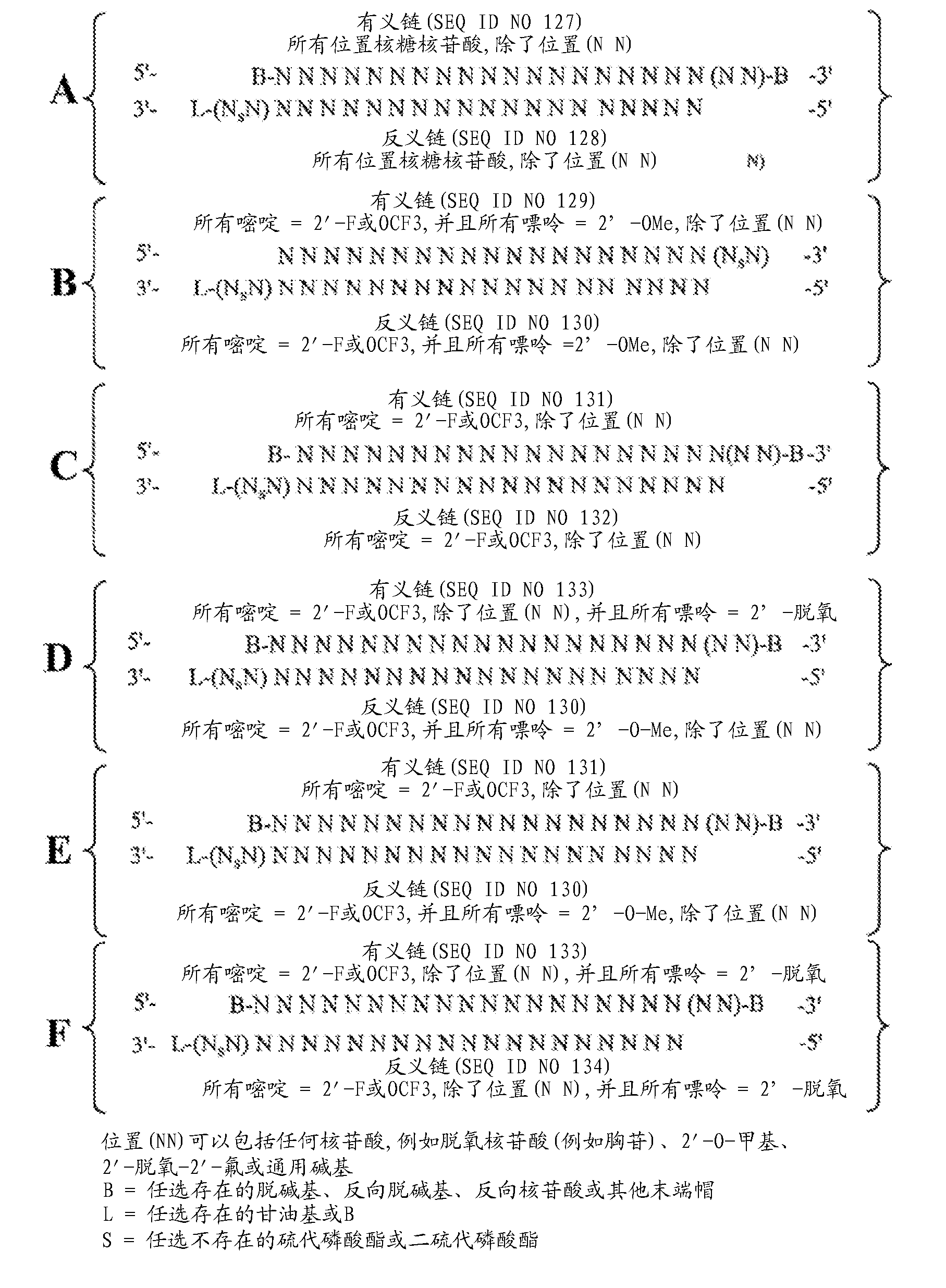Rna interference mediated inhibition of btb and cnc homology 1, basic leucine zipper transcription factor 1 (bach 1) gene expression using short interfering nucleic acid (sina) sequence listing
A technology for interfering nucleic acids, nucleotides, applied in the field of RNA interference-mediated inhibition of BTB and CNC homolog 1, basic leucine zipper transcription factor 1 (Bach1) gene expression using short interfering nucleic acid (siNA) , able to address issues such as Nrf2-dependent antioxidant loss
- Summary
- Abstract
- Description
- Claims
- Application Information
AI Technical Summary
Problems solved by technology
Method used
Image
Examples
Embodiment 1
[0577] Example 1: Design, synthesis and identification of siNAs active against Bach1
[0578] Bach1 siNA synthesis
[0579] A series of 42 siNA molecules were designed, synthesized and evaluated for efficacy against Bach1. The main criteria for the design of Bach1 for human siNAs were (i) homology between the 2 species (human and mouse), and (ii) high efficacy as determined by a proprietary algorithm Score. Mouse sequences were also investigated for use in animal models. The effect of siNA on Bach1 RNA levels and its effect on heme oxygenase-1 (HMOX-1) mRNA levels were also examined. The siNA sequences designed, synthesized and evaluated for efficacy against Bach1 are described in Table 1a (target sequences) and Table 1b (modified sequences).
[0580] Table 1a: Bach1 Target Sequences, Target Sites Indicated. The Homology column indicates the complete homology of the siNA to the human transcript (h), the mouse transcript only (m), and the human and mouse transcript (hm),...
Embodiment 2
[0651] Example 2: In vitro evaluation of siNA in human bronchial epithelial cells
[0652] Duplexes corresponding to 29961-DC, 29964-DC, 29984-DC, 29988-DC, 29957-DC, 29947-DC and 29956-DC were tested for maximal Bach1 mRNA knockdown and potency in human bronchial epithelial cells as follows siNA by ID number.
[0653] Cell culture preparation:
[0654] Human bronchial epithelial cells (NHBE cells) from Lonza (Cat. No. CC-2540) were grown at 37 °C in the presence of 5% CO2 and grown in BEBM minimal medium (Lonza, Cat. No. CC-3171) on Biocoat collagen 1 coated culture flask (Becton Dickinson).
[0655] Transfection:
[0656] NHBE cells were plated in collagen 1-coated plates and cultured in appropriate media. Cells were incubated at 37° C. for 24 hours in the presence of 5% CO 2 after plating. siNA was diluted to 1uM in OptiMEM 1 and transfection reagent was diluted to 25ug / ml. For siNA formulations, equal volumes of diluted siNA and delivery lipids were combined and ...
Embodiment 3
[0673] Example 3: Testing of siNAs for TLR3, TLR7 and TLR8-mediated immune stimulation
[0674] NHBE cells were processed as described above in Example 2 and used to measure endosomal TLR3-mediated immune stimulation, including poly I:C as a positive control for OAS1 mRNA upregulation. For the measurement of membrane-bound TLR3-mediated immune stimulation, NHBE cells were cultured at 1200 cells / 96 wells and treated with (100 nM, 30 nM, 10 nM, 3 nM, 1 nM, 0.3 nM, 0.1 nM, 0.03nM, 0.01nM) siRNA administered in PBS.
[0675] Cell surface TLR3 mediated immunostimulatory responses were measured by noting the % increase in OAS1 mRNA levels when NHBE cells were treated with siNA in the absence of delivery vehicle. (% increase in OAS1 mRNA levels relative to PBS diluent).
[0676] To determine the % increase in OAS1 (immunostimulatory biomarker) mRNA levels mediated by immunostimulatory TLR3, seven siNAs 29961-DC, 29964-DC, 29947-DC, 29988-DC, 29984-DC, 29956-DC and 29957-DC were use...
PUM
 Login to View More
Login to View More Abstract
Description
Claims
Application Information
 Login to View More
Login to View More - R&D
- Intellectual Property
- Life Sciences
- Materials
- Tech Scout
- Unparalleled Data Quality
- Higher Quality Content
- 60% Fewer Hallucinations
Browse by: Latest US Patents, China's latest patents, Technical Efficacy Thesaurus, Application Domain, Technology Topic, Popular Technical Reports.
© 2025 PatSnap. All rights reserved.Legal|Privacy policy|Modern Slavery Act Transparency Statement|Sitemap|About US| Contact US: help@patsnap.com



